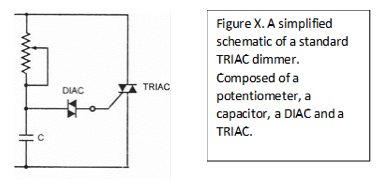Behind the Wire: Newly Patented TRIAC Analyzer Provides Convenient Alternative To Traditional LED Installation And Control
Date: September 20, 2016
Source: Inspired LED LLC.
Authors: Tanner Leland, Kristine Robertson
Summary: Since the introduction of low voltage LED lighting to the mainstream market, installers have been limited to choosing between the simplicity of a plug-in LED system or the convenience of a standard high-voltage wall switch. Given the constraints of each layout, our team at Inspired LED has developed a device which combines the best of both for power and control. After successful testing, the TRIAC Analyzer was awarded U.S. patent number 9,288,851 in March of 2016, and is now commercially available.
In the decade since LEDs first became commercially available, consumers and professionals have been restricted to wiring dimmable low voltage lighting systems in one of two ways. The simplest most inexpensive layouts utilize a plug-in power supply combined with a compatible ‘in-line’ switch, dimmer, or remote, all of which operate at 12V DC. The benefit to these types of systems is their ease of install, which rarely requires the services of an electrician.
If, however, customers prefer to control their LEDs from a more traditional high voltage wall dimmer, installers must first utilize a hardwired dimmable transformer to convert the standard 120 volts AC down to an LED compatible 12 or 24 volts DC. While these hardwired systems may be considered more integrated into the home, they also have a tendency to be much more expensive.

Electricians have attempted to find creative ways to incorporate the best of both worlds into a single configuration. One of the most common workarounds is the “dimmable wall outlet”, which involves the direct connection of a dimmer switch to a standard 120V wall outlet. Unfortunately this solution can lead to a range of electrical issues, creating fluctuations which can damage a plug-in power supply, and even’s lead to electrical fire. For this reason, the connection of a dimmer switch to a standard configuration outlet is defined as a violation of National Electrical Code Sections 404.14E and 406.15.

It was with these challenges in mind that our team at Inspired LED set out to develop a safe, reliable alternative to the traditional method of LED control, combining the simple convenience of a plug-in LED system with the more desirable interface of a hardwired layout. Our initial research revealed that the best way to accomplish this would be to create a device which allowed a standard plug-in power supply to connect directly to a ubiquitous TRIAC wall dimmer. We developed the goal of effectively eliminating the need for high voltage connections or expensive transformers, while still maintaining the appearance of a hardwired LED system.
Our team began by developing a specialized circuit board which could analyze the state of a wall dimmer and adjust the power to the LEDs accordingly.

As voltage is applied to the dimmer, the capacitor builds up an electric charge. Once the voltage of the capacitor exceeds the breakover voltage of the DIAC, the internal TRIAC is activated and begins conducting electricity. The amount of time between applying voltage and activation of the TRIAC is then recorded, the dimmer is discharged, and the process starts over again to make subsequent measurements.

The amount of time required is determined by the RC network formed by the potentiometer and capacitor. Since the dimmer’s slide is physically connected to the potentiometer, and the capacitance is fixed, the precise position of the slide can be determined by the amount of time measured.

At full brightness the dimmer will take the least amount of time to begin conducting electricity, while at the lowest setting it will take longer for conduction to begin, and when off the switch will never conduct. A switch that takes too long to conduct can then be assumed to be off. The amount of time to conduct varies from dimmer to dimmer, so the range of the chosen dimmer is learned by the TRIAC analyzer as the slide is moved to both extremes. Once the position of the slide is known, the brightness of the LEDs is then adjusted accordingly.

The result is an entirely new option for LED system control, one which is more cost effective than a traditional hardwired system, but still offers customers the freedom to adjust their lights from a standard wall dimmer. The exclusion of high voltage lines means the TRIAC Analyzer can be installed by contractors and homeowners without the need to hire an outside electrician.
After months of testing and development, the TRIAC Analyzer was awarded U.S. patent number 9,288,851 in March of 2016. Prototypes were released to select contractors and distributors throughout the month of April, receiving a swell of positive feedback and anticipatory purchase orders. The TRIAC Analyzer is now available for purchase on Inspired LED’s website, as well as in store for the preliminary price of $40.
References:
Vannice, K. (2014, June 20). National Electrical Code® NFPA 70®-2014 [PDF]. Retrieved September 10, 2016, from https://www.nfpa.org/Assets/files/AboutTheCodes/70/ProposedTIA%201151_NFPA70.pdf
Holt, M. (2014, February 05). Retrieved September 12, 2016, from https://www.youtube.com/watch?v=1BDeOHR951g